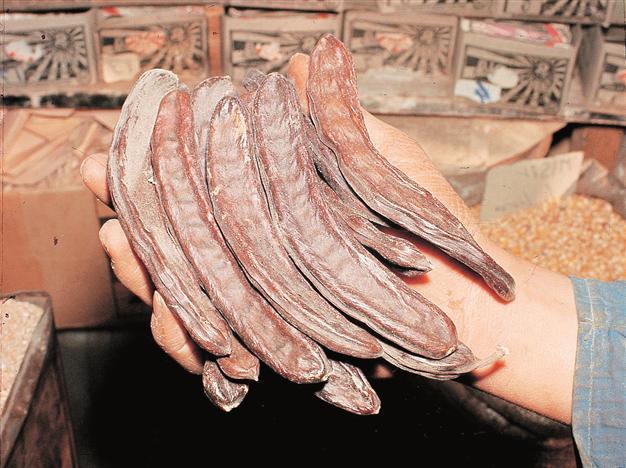Diamonds & dimes
Aylin Öney Tan - aylinoneytan@yahoo.com
 The woody dark brown horn-shaped pods do not look edible at all. They look dry and extremely tough, with seeds as hard as stone. This is how most people perceive carob, especially if one is not from a carob growing geography. One hesitates to call carob a fruit - surely it is not a vegetable, but it is usually referred to as carob bean and it must be nature’s most peculiar food item. Surely it has the most unappetizing looks, ranking as one of the strangest fruits found in the Mediterranean basin.
The woody dark brown horn-shaped pods do not look edible at all. They look dry and extremely tough, with seeds as hard as stone. This is how most people perceive carob, especially if one is not from a carob growing geography. One hesitates to call carob a fruit - surely it is not a vegetable, but it is usually referred to as carob bean and it must be nature’s most peculiar food item. Surely it has the most unappetizing looks, ranking as one of the strangest fruits found in the Mediterranean basin.However, carob, the pod of a small shrub-like tree contains wonders in its unappealing first appearance.
Carob actually tastes good. It has a taste reminiscent of chocolate or dates, but not as strong as high cocoa content chocolate bars and not as sickly sweet as dates, with a subtler note. Eating a carob can be a strangely addictive experience. This must be a sensation that St. John experienced, as he is believed to have survived by solely munching carob pods during his time in the forests of the Taurus Mountains. Some suggest it was locusts that he ate, but the confusion comes from the carob tree, which is also called a locust tree. Whatever he ate, he survived; actually the carob is very good for health, containing lots of fiber. The pure carob diet of the saint is the reason why the carob is also called “St. John’s bread” in many cultures.
The carob seed is very hard and does not have a tendency to swell with moisture or dry out. Because of this resilient nature, a carob seed always remains the same in weight, and for that reason it was used as a weighing scale in measuring precious items like gold or jewelry. It is also believed that every single carob seed on earth was identical in weight, thus making it a trustworthy instrument of measurement. The word carat, a unit of mass for gemstones and diamonds, and a unit of purity for gold, comes from the carob. I was always skeptical of the suggestion about the accuracy of carob seeds, and research revealed that I was not the only one. Lindsay Turnball and her team from Zürich University painstakingly weighed 550 seeds from 28 different trees to find out that there was five percent variability in the weight of the seeds. Still, there seems to be a certain standard that makes them suitable for such precise weighing for precious goods. In the Ottoman era, if a jeweler or gold dealer had a privileged customer, they would throw in a carob seed to the benefit of the customer, like throwing in a dime or two.
The poor carob is a poor man’s survival food, even if its seeds were once involved in measuring gold and gemstones. A sack of carob might have been worth only a few dimes, but even a single carob pod is as precious as a diamond - thanks to its holy liaisons with St. John and its mention in the Epic of Gilgamesh.
Bite of the week
Recipe of the Week: This recipe is a traditional carob pudding, rather
like a sweetmeat, from the Taurus Mountains. Dissolve 6 tablespoons of
starch in a little water. When there are no more lumps left, add more
water to measure 4 cups. Add 2 cups of carob molasses. Mix in 4
tablespoons of sugar, or to taste. Bring this mixture to boil in a
saucepan, constantly stirring. When the mixture reaches boiling point
and starts to thicken, continue to cook, constantly stirring for 5
minutes. Transfer the mixture in a shallow baking pan or glass, or
enamel trays approximately an inch thick. Let cool and gel, you can
refrigerate if you like. When the pudding is completely set, cut into
lozenges or diamond shapes, sprinkle generously with crushed walnuts and
serve as a nibble. Fork of the Week: Zazel’la may sound like an odd name; indeed, it is made from that odd ingredient, the carob. It is a carob cream, a new product in the market, to be used like a chocolate spread on toast. Carob cream sounds like an oxymoron, as is not easy to imagine the tough woody pod turned into a velvety creamy spread. However, a Turkish food engineer, Prof. Dr. Mahir Turan from Mersin University, has made this possible. Zazel’la is a mostly pure micro granulized liquidized carob with carob seed powder and sesame paste. The result is a pleasantly satisfying alternative to commercial overly sweet cacao spreads. http://zazel.com.tr
Cork of the Week: There are many drinks made with carobs in the Mediterranean, mainly in islands such as Sicily, Malta, and Cyprus. The Siracuse specialty in Sicily is Carrubone, in Malta it is Harruba. Cypriots refer to the carob syrup as black gold, which is also used to heal sore throats.
















